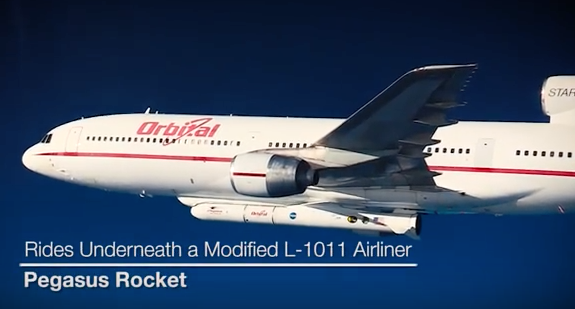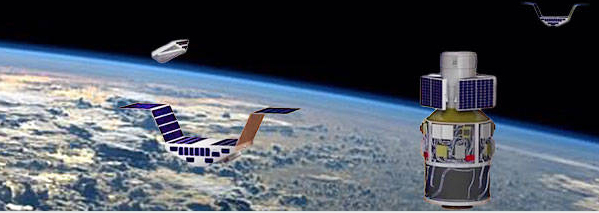

Here's a unique concept... a rocket that is strapped underneath an airplane that is released while in flight... this is the description of NASA's Pegasus XL rocket that was scheduled to release eight small satellites to space today, however it was scrubbed due to heavy clouds at the drop site and a hydraulic pump that failed to work properly. A second launch attempt was scheduled for 9:05AM ET, but that also had to be aborted due to the failing pump that helps to release Pegasus from Stargazer. Orbital ATK says that a circuit breaker was affecting the pump​. The CYGNSS mission's goal is for the satellites to study various aspects of tropical storms and hurricanes from orbit, in order to help scientists better understand how these cyclones form.
Pegasus XL rocket, manufactured by private spaceflight company Orbital ATK was forced to change their plans for a launch at the last moment. The agency aborted the launch just before the launch window closed at 9:19AM ET. NASA will try again Wednesday 8:20AM ET, as long as the issues that affected today's launch are resolved.
NASA's blog offered minimal information ...

Today’s launch of NASA’s CYGNSS spacecraft has been scrubbed due to problems with the hydraulic pump that controls the release of the Orbital ATK Pegasus XL rocket from the L-1011 carrier aircraft. A hydraulic pump aboard the Orbital ATK L-1011 airplane, which is required to release the latches holding Pegasus in place, is not receiving power. Teams will assess the issue after the plane lands.
The aircraft is on its way back with the Pegasus XL rocket still safely attached.
The next possible launch opportunity is Tuesday, pending resolution of the pump issue.
The Pegasus XL rocket launches after being dropped from the belly of an airplane after Orbital’s Stargazer L-1011 aircraft takes off from Cape Canaveral, Florida and carries the rocket to a target drop zone over the Atlantic Ocean, an area that sits at an altitude of 39,000 feet. There, the Pegasus is released and ignites its main rocket motor about five seconds later. The vehicle hen ignites two additional motors over the course of the flight to achieve the correct altitude and orientation for the eight spacecraft to deploy properly into lower Earth orbit.
Then the sats drop in pairs every 30 seconds from the deployment module, a tube-like structure that the satellites are connected to throughout launch. Approximately 10 minutes after one satellite deploys, it will automatically open up its solar arrays to get energy from the Sun for a total amount of time of about 14 and a half minutes.
NASA makes contact with the satellites about three hours after they’ve deployed. The CYGNSS satellites study the ocean surface winds within the inner cores of hurricanes that indicate the storm's intensity. These probes receive reflected signals from GPS satellites that enables the CYGNSS team to "see" through the parts of hurricanes where it’s raining and measure the surface winds in those areas. Until now this has not been possible for Earth science missions to accomplish. These measurements will help scientists better predict how strong a hurricane or storm is going to be when it makes landfall.
If NASA can get the pump issue fixed before Wednesday, then the agency will try to launch the Pegasus again Wednesday morning at 8:20AM ET.

